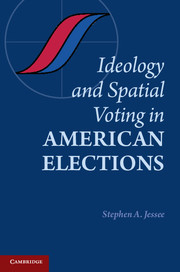Book contents
- Frontmatter
- Contents
- List of Figures
- List of Tables
- Preface
- 1 Introduction
- 2 Political Ideology
- 3 Measuring Political Ideology
- 4 Linking Theory and Empirics: Testing Spatial Voting Theory
- 5 Partisanship versus Proximity: The Effect of Party Identification on Spatial Voting
- 6 Political Information and Spatial Voting
- 7 The Political Perceptions of Citizens
- 8 Conclusion
- Appendix A Survey Question Wordings
- Appendix B Survey Sample Characteristics
- Appendix C Simplified Analyses of Ideology and Spatial Voting
- Appendix D American National Election Studies Analyses
- Bibliography
- Index
5 - Partisanship versus Proximity: The Effect of Party Identification on Spatial Voting
Published online by Cambridge University Press: 05 August 2012
- Frontmatter
- Contents
- List of Figures
- List of Tables
- Preface
- 1 Introduction
- 2 Political Ideology
- 3 Measuring Political Ideology
- 4 Linking Theory and Empirics: Testing Spatial Voting Theory
- 5 Partisanship versus Proximity: The Effect of Party Identification on Spatial Voting
- 6 Political Information and Spatial Voting
- 7 The Political Perceptions of Citizens
- 8 Conclusion
- Appendix A Survey Question Wordings
- Appendix B Survey Sample Characteristics
- Appendix C Simplified Analyses of Ideology and Spatial Voting
- Appendix D American National Election Studies Analyses
- Bibliography
- Index
Summary
Most Americans have this sense of attachment with one party or the other. And for the individual who does, the strength and direction of party identification are facts of central importance in accounting for attitude and behavior.
(Campbell, Converse, Miller, and Stokes 1960, 121)Perhaps the most influential work on voting behavior in the United States is The American Voter by Campbell, Converse, Miller, and Stokes (1960). While the book touches on a number of areas of political behavior, it is most widely cited for its emphasis of party identification – longstanding and largely unchanging loyalties to a political party, usually developed by voters at a young age – as the primary determinant of vote choice and other political actions. The American Voter stands as the central work of the so-called Michigan school of political behavior, which argues that voters are overwhelmingly unsophisticated, making political decisions without much planning or reason, and guided mostly by a sense of personal loyalty to one of the two major political parties.
Most works categorized under the Michigan school umbrella downplay policy ideology not only as a meaningful predictor of vote choice, but also as existing in the first place for the majority of voters:
We have seen that the stable qualities of the public's response to political affairs have to do primarily with long-term loyalties to the parties rather than ideological commitments against which current acts or policies of the parties could be evaluated. The forces not based on party loyalty that influence the decisions of the American electorate appear almost wholly free of ideological coloration. (550)
- Type
- Chapter
- Information
- Ideology and Spatial Voting in American Elections , pp. 103 - 130Publisher: Cambridge University PressPrint publication year: 2012



